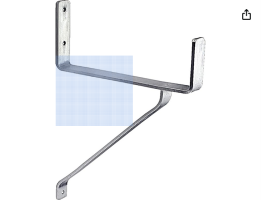S
Suizident
Member
- Aug 7, 2025
- 9
Hello,
How could an anchor point for a partial suspension hang (perhaps also a full suspension hang,
but more likely a partial suspension hang) be achieved under the following conditions:
The conditions are:
- Relatively low ceilings, approx. 7.54 feet
- Suspended ceilings made of plasterboard (for sound insulation)
- Brick exterior walls, probably sandstone (as it is an old building), but perhaps also modern bricks from a previous renovation
- Body weight approx. 143.3 pounds
- Body length approx. 70.86 inches
In my opinion, the load-bearing capacity of the ceilings is too low to attach a secure anchor point
there. Full suspension would then also be out of the question.
That leaves a partial suspension hang on one of the brick exterior walls.
This means I would have to attach a secure anchor point to one of the exterior walls, perhaps
with heavy-duty anchors to be on the safe side. I thought of a towel rack, but I could imagine
that the towel rack or its mounting bracket might break off, even if the anchors hold.
Does anyone have a better idea?
The possible anchor points described in various sources (e.g., window handles, door handles,
clothes rails) do not exactly inspire confidence: too low, could break off,
neighbors or passers-by could hear noises.
-------
In connection with the anchor points, I believe that the selection of a suitable
body posture is also important; perhaps this should also be made dependent
on the anchor point, among other things.
Here is a picture showing possible body positions that can generally be adopted during a
partial suspension hang:
What I wonder about all these positions is whether, before or after losing consciousness,
the natural survival instinct leads to leaving the predicament (e.g., by standing up) and thus taking
the pressure off the carotid arteries?
Of the possible body positions in the image linked above, the position
in row 3, column 1 seems most likely to prevent this: standing up to relieve the
pressure on the carotid arteries seems most difficult from this position. On the other hand,
another position might be better for control freaks, to give them a feeling of control and avoid
panic and thus mistakes.
Furthermore, it may also be the case that the attempt has to be aborted if something does not work.
I look forward to constructive feedback! :)
Many thanks and best regards,
Suizident
How could an anchor point for a partial suspension hang (perhaps also a full suspension hang,
but more likely a partial suspension hang) be achieved under the following conditions:
The conditions are:
- Relatively low ceilings, approx. 7.54 feet
- Suspended ceilings made of plasterboard (for sound insulation)
- Brick exterior walls, probably sandstone (as it is an old building), but perhaps also modern bricks from a previous renovation
- Body weight approx. 143.3 pounds
- Body length approx. 70.86 inches
In my opinion, the load-bearing capacity of the ceilings is too low to attach a secure anchor point
there. Full suspension would then also be out of the question.
That leaves a partial suspension hang on one of the brick exterior walls.
This means I would have to attach a secure anchor point to one of the exterior walls, perhaps
with heavy-duty anchors to be on the safe side. I thought of a towel rack, but I could imagine
that the towel rack or its mounting bracket might break off, even if the anchors hold.
Does anyone have a better idea?
The possible anchor points described in various sources (e.g., window handles, door handles,
clothes rails) do not exactly inspire confidence: too low, could break off,
neighbors or passers-by could hear noises.
-------
In connection with the anchor points, I believe that the selection of a suitable
body posture is also important; perhaps this should also be made dependent
on the anchor point, among other things.
Here is a picture showing possible body positions that can generally be adopted during a
partial suspension hang:
What I wonder about all these positions is whether, before or after losing consciousness,
the natural survival instinct leads to leaving the predicament (e.g., by standing up) and thus taking
the pressure off the carotid arteries?
Of the possible body positions in the image linked above, the position
in row 3, column 1 seems most likely to prevent this: standing up to relieve the
pressure on the carotid arteries seems most difficult from this position. On the other hand,
another position might be better for control freaks, to give them a feeling of control and avoid
panic and thus mistakes.
Furthermore, it may also be the case that the attempt has to be aborted if something does not work.
I look forward to constructive feedback! :)
Many thanks and best regards,
Suizident

